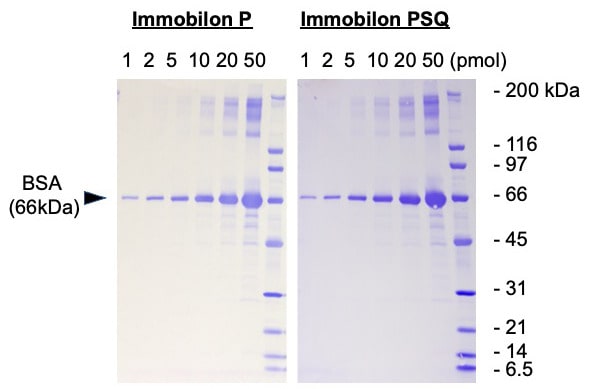How to prepare samples for N-terminal Edman microsequencing
Laboratory of Biomolecular analysis, Institute for Protein Research, Osaka University
2021.11.16 updated
Samples should be prepared either as a blot on a PVDF membrane, salt-free protein solution, or HPLC fraction of a peptide. For protein analysis, PVDF membrane is most often used because it is easy to remove salts and other impurities.
At least 2 pmol are required for analysis on Procise and 10 pmol for PPSQ. If samples are transfered on a PVDF membrane, transfer efficiency should be taken account.
Blot on PVDF membrane
- Samples should be separated by SDS-PAGE, transfered to a PVDF membrane, stained with CBB-R250, and cut from the membrane with a scisers so as not to have large vacant area. It is not necessary to destain the protein band.
Example(Protocol)

- Either Immobilon P or Immobilon PSQ works well for most proteins. However, the latter has higher protein-binding activity especially for low mw (<2kDa) proteins or strong transfer conditions. For more in detail, please see Protocol
.
- Typical transfer buffer systems are shown below.
- CAPS buffer (10 mM CAPS, pH 11, 10% Methanol) : In the original paper by P. Matsudaira (JBC 262, 10035-10038, 1987) this buffer was used for tank transfer, but it also works well with semidry transfer.
- Tris-Glycine (Towbin's) buffer(25 mM Tris、192 mM Glycine、20% Methanol): It works well in most case. But it contains high-concentrations of glycine and tris, which may detected in the first few cycles of Edman degradation. So, it would be better to use CAPS buffer.
-
Higher Mw. proteins are more difficult to transfer. CAPS buffer works much better for High Mw. proteins. If CAPS buffer shows incomplete transfer with a semidry system, it is recommended to try tank transfer.
Protein solution
- Sample should be free of salts and detergents. If samples contain compounds that are difficult to remove, it is highly recomended to apply the samples on SDS-PAGE and blot on a PVDF membrane.
HPLC fractions
- Solvents prepared with Water/Acetonitrile/TFA are recommended.
- Organic solvents should be HPLC grade or higher.
- Avoid using solvents including salts such as phosphate or aetate.
